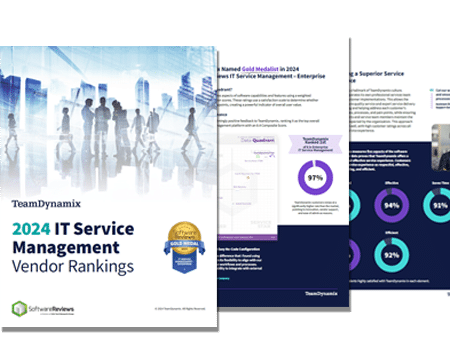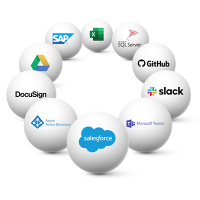
What is ITIL? Understanding ITIL’s Role in Improving Service Delivery
When it comes to improving IT Service Management (ITSM) maturity, many organizations turn to ITIL – a framework that guides users through a process-based approach

The Info-Tech ranking report offers a unique view of the market based entirely on in-depth customer interviews. Download the Info-Tech ITSM Quadrant and Customer Viewpoint report today.

We’ll show you some of our best situations and show you exactly how to execute them to get immediate results. The best part is, iPaaS tools often feature easy-to-use click and drag functionality, meaning you don’t need a dedicated employee building integrations and workflows.

System Integrators, Value Added Resellers, Technology Providers, and Buying Consortiums can benefit from a partnership with TeamDynamix.

The Info-Tech ranking report offers a unique view of the market based entirely on in-depth customer interviews. Download the Info-Tech ITSM Quadrant and Customer Viewpoint report to gain a better understanding of key vendor strengths and emerging market requirements.
As organizations continue to optimize IT resources and find new ways to alleviate the drain caused by increased demand on the IT help desk – more and more IT leaders are placing importance on Knowledge-Centered Service (KCS®). In fact, many who have implemented KCS are now seeing significant improvements in incident resolution and customer/employee satisfaction. With KCS, you crowdsource knowledge from your user base to build a knowledge base that can then be used as part of your self-service portal – the challenge is how to document and enhance this knowledge for crowd consumption.
Ultimately knowledge is at the heart of any service management deployment. Whether it is in IT, facilities or HR, the ability to harness and use collective knowledge is a key success measure. We all know this; so why is it so often left as an afterthought?
The reality is that there are bottlenecks, review cycles, and other fires to put out and in the end, the knowledge base is often left to atrophy. Enter KCS – a crowd-sourced information resource. By harnessing the information, and offering a clear structure and framework for gaining feedback, organizations can publish more information, more accurately.
KCS is a widely adopted methodology established by the Consortium for Service Innovation. It provides value to organizations and communities by making knowledge abundant and available so that problems can be solved. KCS is often used as part of an IT Service Management (ITSM) strategy to push people to self-service their IT issues using a knowledge base as part of a service portal.
There are four KCS principles, the first being abundance. When an issue arises, it is either a known issue or a new issue. When someone presents a known issue, they are connected to the content that will help walk them through a solution. When someone presents a new issue, they are connected to a person who will help them solve the problem. This is why an abundance of knowledge is important- it leads to fewer issues that need to be handled by a person.
The second principle of KCS is being demand-driven. When content is created for people to use in order to solve a problem, there should be a reason. Creating content for the sake of creating content is a waste of time because there is a chance that the knowledge article someone writes will never be referenced. Don’t write about what you think people want to know, write about what they actually want to know. This ties into another principle, which is creating value. Articles that are used continuously obviously hold more value than an article that is never looked at. Being intentional about the content you create is how you ensure that value is a focus.
The last principle is trust. With people relying on written information to solve their problems rather than a person, it is incredibly important that they trust what they are reading. If they don’t, they are going to disregard a knowledge base article and go straight to a person to get help. This would completely defeat the purpose of a knowledge base, so it is very important that an organization is responsible for the knowledge that it has in order to gain trust.
How Knowledge-Centered Service is approached can vary based on a variety of factors, but it certainly can and should be part of your IT Service Management (ITSM) processes. While there will always be incidents reported and service requests made that are unique in some way, have you ever run a report to determine the number (or percentage) of inbound calls or requests that can be repeatedly traced back to things like Wi-Fi passwords or where to go for XYZ on campus? If you’re not taking stock of the vast amounts of knowledge you already have at your fingertips and you’re not using that knowledge to your advantage, you’re doing yourself—and your customers—a disservice.
KCS, managed by the KCS Academy, is the most common form of support.
KCS stipulates that the creation and maintenance of knowledge must be fully integrated into the most important support operations. Support documentation and knowledge base articles are reduced to “dos and don’ts” whenever a technician has free time.
Knowledge-Centered Services can be so powerful, and here are reasons why:
KCS is a customer support approach that emphasizes the creation, maintenance and sharing of knowledge throughout an organization to enhance the delivery of exceptional service.
To implement KCS effectively, organizations can follow three best practices.
Firstly, they can encourage frontline staff to document and share their knowledge by creating a centralized knowledge base accessible to all team members. For example, a help desk agent can add troubleshooting steps to the knowledge base after successfully resolving a technical issue for a customer.
Secondly, organizations should promote collaboration and collective problem-solving among teams. By encouraging employees to contribute to the knowledge base and engage in discussions, organizations can tap into the collective expertise of their workforce.
For instance, a software development team can collaborate with customer support representatives to identify areas of improvement and update the knowledge base accordingly.
Finally, organizations can leverage self-service options to empower customers with easy access to relevant information. By providing FAQs, user guides and tutorials, companies enable customers to find answers to their questions independently, reducing the need for direct support interactions.
For instance, an e-commerce platform can offer comprehensive product guides and video tutorials to help customers troubleshoot common issues. By implementing these best practices, organizations can establish a strong foundation for KCS, ensuring consistent and effective customer support.
Case Resolution
Optimizing Your Use of Resources
Self-Service Adoption
Organizational Learning/Knowledge Transfer
©KCS® is a service mark of the Consortium for Service Innovation™.

When it comes to improving IT Service Management (ITSM) maturity, many organizations turn to ITIL – a framework that guides users through a process-based approach

Enterprise Service Management (ESM) is the practice of extending IT Service Management (ITSM) principles beyond the IT department to other areas of an organization. ESM

As businesses grow, so does the complexity of managing their services. This is where Enterprise Service Management (ESM) comes in, offering a structured approach to
TeamDynamix’s award-winning SaaS cloud solution offers IT Service and Project Management together on one platform with enterprise integration and automation.
[email protected]
(877) 752-6196
Contact Us
